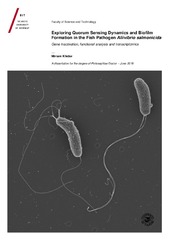Exploring Quorum Sensing Dynamics and Biofilm Formation in the Fish Pathogen Aliivibrio salmonicida
Permanent lenke
https://hdl.handle.net/10037/16612Dato
2019-10-22Type
Doctoral thesisDoktorgradsavhandling
Forfatter
Khider, MiriamSammendrag
The marine pathogen Aliivibrio salmonicida is the causative agent of cold-water vibriosis, affecting mainly farmed salmonid fish when water temperatures are below 10°C. Even though cold-water vibriosis is no longer threatening Norwegian aquaculture, the reemergence of the disease is still a possibility. Therefore, it is crucial to gain knowledge and understanding of the pathogenicity of A. salmonicida. Quorum sensing (QS) is one of the communication systems used by bacteria to regulate gene expression in a synchronized way in response to cell density by secreting and sensing extracellular signals called autoinducers (AIs). QS system controls various physiological processes, particularly virulence system and biofilm formation in many pathogenic bacteria. With the increased emergence of antibiotic-resistant in recent years, understanding and targeting QS system is expected to bring potential new breakthroughs for the prevention and treatment of Vibrio infections. The present work was initiated to increase the knowledge on the QS system and its regulation on phenotypic traits that may be important for survival and host-pathogen interaction in A. salmonicida.
Alternative sigma factors such as RpoS provide the main line of responses to changes in the environment by altering gene transcription. In several vibrios, RpoS has been shown to be connected to QS system. The obtained results in this thesis, clearly indicate that an RpoS-like sigma factor, RpoQ (VSAL_II0319) is a component of the QS system and involved in regulating colony rugosity, biofilm formation, and motility in a cell density dependent manner. The transcriptomics analysis further revealed that RpoQ is involved in influencing expression of a large panel of genes including the syp operon involved in polysaccharide production. This suggests that the downregulation of biofilm development and wrinkled colony phenotype were due to RpoQ-dependent repression on polysaccharide biosynthesis genes (syp genes) at high cell density. In addition to cell density dependent control on biofilm formation and colony rugosity through QS, temperature was shown to influence the regulation of RpoQ on these phenotypes, linking this environmental factor to the development of cold-water vibriosis in seawater at low temperatures.
Previous reports have shown that A. salmonicida possesses two functional autoinducer synthases, the LuxI and AinS, which are responsible for the production of eight acyl homoserine lactones (AHLs). In this thesis, the inactivation of luxI, but not ainS, led to the formation of wrinkled colonies similar to those formed by the ΔrpoQ mutant. The transcriptome analysis showed that LuxI is required for repression of syp expression, where repression of syp is likely operated through the RpoQ sigma factor. When both systems were inactivated simultaneously, strains (ΔainSluxI−) with wrinkled colonies and mushroom structured biofilm were formed. Furthermore, the exogenous addition of either LuxI, N-3-oxo-hexanoyl-L-homoserine lactone (3OC6-HSL) or AinS, N-3-hydroxy-decanoyl-L-homoserine lactone (3OHC10-HSL), to the ΔainSluxI- double mutant, inhibited biofilm development. This suggested that the downregulation of biofilm formation is operated through a common pathway when the AHL concentrations are high.
The results presented in this work, add new knowledge about the nature of the QS mechanism of A. salmonicida and elucidate some aspects of the complex mechanism of biofilm formation, contributing to advancement of research in this field.
Har del(er)
Paper I: Khider, M., Willassen, N.P. & Hansen, H. (2018). The alternative sigma factor RpoQ regulates colony morphology, biofilm formation and motility in the fish pathogen Aliivibrio salmonicida. BMC Microbiology, 18, 116. Also available in Munin at https://hdl.handle.net/10037/15091.
Paper II: Khider, M., Hjerde, E., Hansen, H. & Willassen, N.P. (2019). Differential expression profiling of ΔlitR and ΔrpoQ mutants reveals insight into QS regulation of motility, adhesion and biofilm formation in Aliivibrio salmonicida. BMC Genomics, 20, 220. Also available in Munin at https://hdl.handle.net/10037/15095.
Paper III: Khider, M., Hansen, H., Hjerde, E, Johansen, J.A. & Willassen, N.P. (2018). Exploring the transcriptome of luxI- and ΔainS mutants and the impact of N-3-oxo-hexanoyl-L- and N-3-hydroxy- decanoyl-L-homoserine lactones on biofilm formation in Aliivibrio salmonicida. PeerJ, 7, e6845. Also available in Munin at https://hdl.handle.net/10037/15310.
Forlag
UiT Norges arktiske universitetUiT The Arctic University of Norway
Metadata
Vis full innførselSamlinger
Følgende lisensfil er knyttet til denne innførselen:


 English
English norsk
norsk
